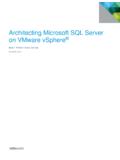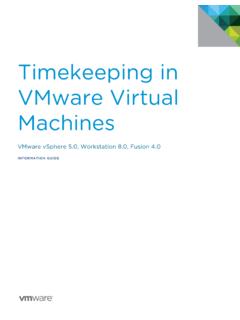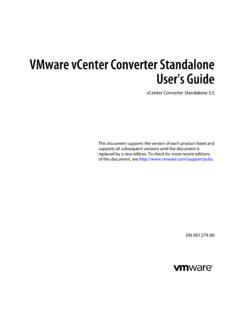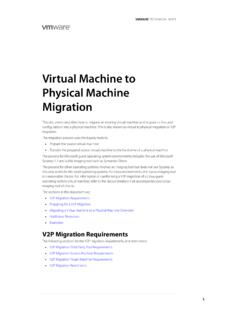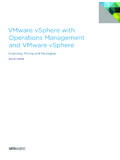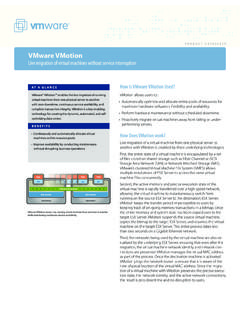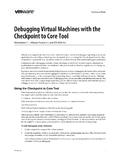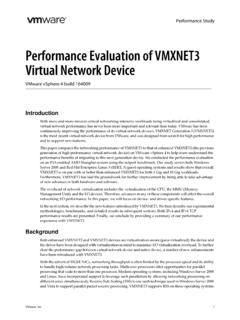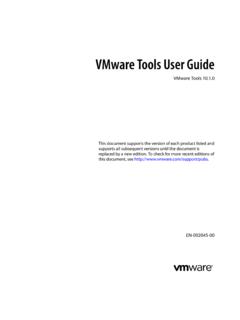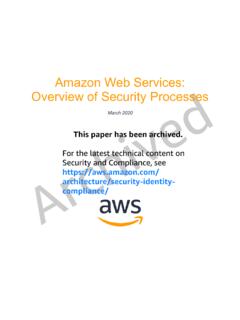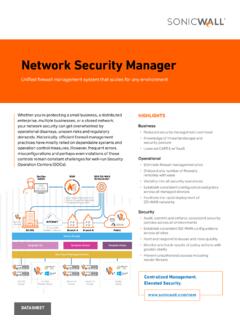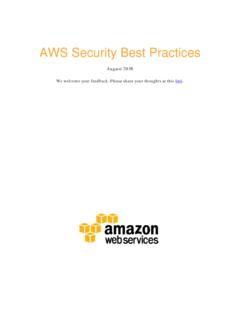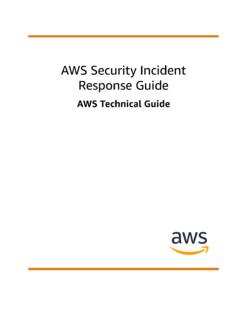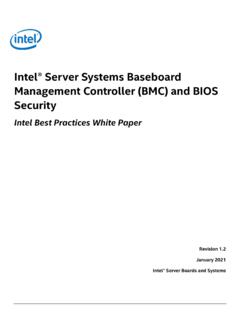Transcription of Best Practices for SQL Server on Azure on VMware Solutions
1 TECHNICAL WHITE PAPER SEPTEmbER 2021 Successfully Virtualizing Microsoft SQL Server for High Availability on Azure VMware SolutionsBEST Practices GUIDEBEST Practices GUIDE | 2 Table of contents Introduction ..3 Target Audience ..3 Architectural Guidelines and Operational Considerations for Running SQL Server on Azure VMware Solutions ..3 Use Case Definition ..4 Rightsizing ..4 Requirements ..5 Risks, Assumptions and Constraints ..5 High-Level Architecture ..6 Logical Design ..6 Operational Considerations ..6 Configuration Checklist for Hosting Microsoft SQL Server Workloads on AVS ..7 Memory Allocation ..7 Memory Reservation ..7 CPU Allocation ..8 Beware of Limit ..9 Network Card Configuration ..9 SCSI Controller Configuration ..11 Disk Allocation and Configuration ..12 Power Setting Configuration ..12 Deploying and Preparing a VM for Windows Server Failover Clustering ..14 Overview ..14 Deployment Steps ..14 Installing Windows Server Failover Clustering.
2 16 Windows Server Failover Clustering Configuration ..23 Installing and Configuring Microsoft SQL Server Always On Failover Clustering Instance on AVS ..35 Enable (Persistent) TraceFlag 1800 ..37 Adjust WSFC Cluster Heartbeat Thresholds: ..39 Installing and Configuring Microsoft SQL Server Always On Availability Group on AVS ..41 Conclusion ..58 Successfully Virtualizing Microsoft SQL Server for High Availability on Azure VMware SolutionsBEST Practices GUIDE | 3 Successfully Virtualizing Microsoft SQL Server for High Availability on Azure VMware SolutionsIntroduction This document describes the steps and tasks involved in design and configuring a sample Azure VMware solution infrastructure to optimally support a virtualized production Microsoft SQL Server workload. It is intended to provide a representative list of configuration options, architectural guidelines and operational considerations based on the standard Practices documented in VMware s published best Practices for virtualizing Microsoft SQL Server workloads on the VMware vSphere provide a broader view of these options, this document describes a 3-node cluster of Microsoft SQL Server instances configured as follows: A 2-node failover clustering instance (FCI) configuration consisting of two Windows Server 2019 VMs hosting an instance of Microsoft SQL Server and configured for high availability.
3 A 2-node always on availability group (AG) consisting of two Windows Server 2019 VMs hosting a high-availability configuration of a database. One of the VMs in both scenarios described above is simultaneously participating as a Node in each of the configurations. Always refer to the following architectural and best Practices guides for the latest and most comprehensive information when designing your VMware vSphere-based hybrid cloud infrastructure. These documents (individually and collectively) will remain the authoritative sources for information related to running Microsoft SQL Server workloads on the vSphere platform and any hybrid- or public-cloud based derivative: SQL Server on vSphere best Practices Guide Planning Highly Available, Mission Critical SQL Server Deployments with VMware vSphere Considerations for running Microsoft SQL Server workloads on VMware vSAN Architecting Microsoft SQL Server on VMware vSphere best Practices Guide Target Audience This document assumes a knowledge and understanding of VMware vSphere and Microsoft SQL Server .
4 Other than in passing, this document does not describe features, architecture, management or administration of VMware vSphere or Microsoft s Azure Platform and components. Where necessary, this document includes links to existing references and screenshots for the purpose of illustration staff can use this document to gain an understanding of how the system will work as a whole as they design and implement various components. Engineers and administrators can use this document as a catalog of technical capabilities. Database administrator (DBA) staff can use this document to gain an understanding of how Microsoft SQL Server might fit into a virtual infrastructure. Management staff and process owners can use this document to help model business processes to take advantage of the savings and operational efficiencies achieved with virtualization and hybrid cloud. Architectural Guidelines and Operational Considerations for Running SQL Server on Azure VMware Solutions Azure VMware Solutions (AVS) allows users to create vSphere-based data centers (SDDCs) on AVS.
5 Each deployed SDDC includes VMware ESXi hosts, VMware vCenter Server , VMware vSAN , VMware NSX components and other software. The same HTML5-based vSphere client is used to manage a SDDC once deployed. This approach allows seamless migration of demanding application workloads without the need to adopt new toolsets or refactor application components. The planning and designing phase is very important to ensure that migrations of mission-critical application workloads to Azure VMware Solution complete without negatively impacting application SLAs or affecting the performance, availability, manageability and scalability of the workloads. This document summarizes architectural guidelines which will help enterprises when planning a migration. best Practices GUIDE | 4 Successfully Virtualizing Microsoft SQL Server for High Availability on Azure VMware SolutionsUse Case DefinitionThe following uses cases have been identified as the most frequently employed for SQL Server workloads on Azure VMware Solutions : Data center extension, like cloud-bursting and test/dev Workloads health and performance Workload high availability Data center evacuation Disaster recovery with site resilience Application migration and modernizationEach particular use case, or combination of use cases, influences general solution design and necessitates appropriate requirements gathering.
6 This document focuses on use cases specific to workloads health, performance and high availability. We address the health and performance aspects of our objectives by providing a checklist of the common configuration options and recommendations required to avoid common performance bottlenecks in a typical virtualized Microsoft SQL Server infrastructure. We believe that, instead of repeating the usual exercise of providing performance metrics (which we continue to do in separate documents), it is more beneficial that we provide you with actionable configuration tips and recommendation to make your virtualization experience considering where to place SQL Server workloads on a cloud platform, ensure that your virtual machine is right-sized. A workload s performance profile should be collected over a sufficient period of time to reflect applications steady state, peaks and spikes in resource utilizations. While defining the required time range to collect time series data, consult with DBAs and application owners to understand the workload profile.
7 At least a full month of non-rolled up time series data is recommended prior to executing the performance analysis. Utilizing the VMware vRealize Suite Management Pack for Microsoft SQL Server ( ) is proven to be very helpful in this preparation phase. While analyzing captured data, make sure your rightsizing approach has been agreed upon by administrators, application owners and business owners, and that it encompasses both spikes ( , high performance) and average utilization ( , higher density).Microsoft s AVS Assessment with Azure Migrate is also a very useful tool to employ at this phase of your planning, sizing and following should be considered while sizing SQL Server workloads: For CPU and memory resources allocation, check Common questions about Azure VMware Solution to become familiar with the host s compute maximums and to verify the workload will fit and not overcommit host resources. Account for differences in physical CPU architectures between your current environment and the host instances used in Azure VMware Solution.
8 Always size the CPU resource based on the actual workload, as vCPU can be easily added later. Unnecessarily over-allocating compute resources to a VM can have an adverse performance impact on the workloads. Hot-adding CPUs to a VM running Microsoft SQL Server instances is not recommended. Enabling vCPU HotAdd creates fake NUMA nodes on Windows (83980) ( ) CPU HotAdd for Windows VMs: How BADLY Do You Want It? - Virtualize Applications ( ) Note that the storage layer in Azure VMware Solution is provided by hyperconverged infrastructure (HCI) Solutions VMware vSAN. Adding storage will require the addition of compute resources ( , hosts) as well. You can use Azure storage services ( , storage accounts, table storage, blob storage) to augment storage for workloads running in your Azure VMware Solution Practices GUIDE | 5 Successfully Virtualizing Microsoft SQL Server for High Availability on Azure VMware SolutionsRequirementsA crucial part of a successful migration is collecting business and technical requirements, allowing you to properly design a cloud platform.
9 For guidance, review Preparing for Azure VMware Solutions before beginning your requirements requirements are an important part of the requirements gathering process. Input examples include: RTO/RPO targets Business SLAs for the applications workloads based on SQL Server databases Licensing considerations Azure Hybrid Benefit security and data-management considerationsTechnical requirements will directly influence logical design and should be collected and validated with care. Pay special attention to the following bullet points: Performance requirements of the workload ( , transactions-per-second, number of user connections, expected future workloads changes) Capacity requirements ( , future growth, other projects to be served) Scalability requirements ( , method for increasing capacity of a SDDC, scale-out versus scale-in approach) Application requirements ( , type of workloads [ , OLTP/data warehouse], dependencies between on-premises components and network flow between them) Manageability requirements ( , providing access to a SDDC to appropriate user groups, reconfiguring monitoring tools, backup solution in use, modifying scripting, vRealize Operations workflows) Availability requirements ( , SQL Server high-availability Solutions in use, DRS groups, host-isolation response, number of availability zones required)NOTE.
10 Manageability and Availability are two important considerations we will discuss in greater details in this document. This is because, due to its hosted and managed-services nature, AVS provides restricted administrative access to the underlying infrastructure. This level of access limits certain configurations that require assisted support and which cannot ordinarily be performed by the , Assumptions and ConstraintsEnsure that risks, assumptions and constraints are identified and documented and that the risk-mitigation plan has been agreed by all groups involved. An example of an assumption: Do you have a software assurance agreement for Microsoft SQL Server licensing? An example of a constraint: available network bandwidth between on-premises and SDDC ( , is ExpressRoute available?) The scenario described in this document assumes that there is connectivity between the on-premises VMware vSphere infrastructure and the Azure VMware Solution environment The examples shown in this document present a stretched-network scenario in which one network subnet is in use across both environments.
